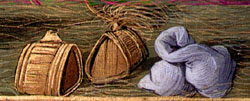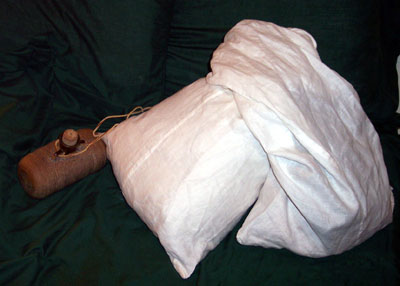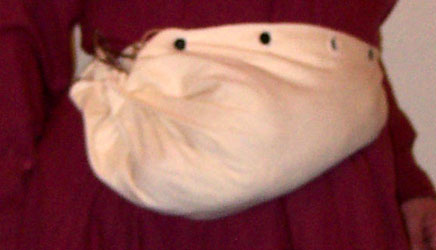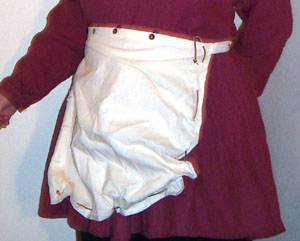

Main Menu - Misc. - Clothing/Textiles - Medieval Wales - Names - Other Medieval - Publications - Harpy Publications
Return to main page
Just for my own interest, I made models of two other pouch styles seen in my data -- both used once by shepherds.


One is the "double-ended bag" style most commonly associated with field-workers or travelers. (Although I haven't cataloged them specifically, there are several examples in my data of Nativity scenes where the Holy Family carries one of these while traveling, see e.g., the Atri fresco annunciation. I used the full width of my 60" linen for the length, which resulted in a fairly large bag, but one in the range of sizes seen. The other dimension of my starting piece was ca. 36". To form the bag, I simply sewed the long edges together to form a tube, but leaving the central approx. 20" open. (The seams were flat-felled, and the open section was then given a folded hem.) The ends were then flattened so that the long seam fell in the middle of one side, and with the bag inside out, the ends were folded over for about an inch and then sewn through all the layers in two parallel lines (for extra strength).

The bag can be slung over the shoulder, but perhaps even more characteristically is placed over the back of a horse or donkey. It can carry a very large volume of contents securely, but somewhat awkwardly, and the contents can be accessed while it is being carried.



The second variant style of purse is the one seen in the Stockholm-Kessel Hours, which I tried simply because it is so clearly shown and so unusual in appearance. I began with a square of canvas roughly 24" on a side, and two strips about 3" wide and respectively about 24" and 12" long. Because of the nature of my fabric, I added the straps to the sides of the main piece, but it could also have been done with a single continuous strap to which the square was sewn. I sewed the straps into tubes and turned them. Then I hemmed the square on all sides, with the side that would become the waistline having an extra deep hem into which the ends of the straps were sewn (with several rows of reinforcing stitches). On one vertical edge, I added four buttonholes (leaving about 6" between the outermost holes and the edges of the fabric) and corresponding buttons on the deep hem along the waist. In each of the other two edges (which should be adjacent to each other), I used an awl to make eight evenly-spaced holes and threaded a leather bootlace through them, then knotted the ends to prevent them from pulling out. (The lace is not quite long enough to allow the fabric to expand to a flat position, but it opens as widely as needed.)

With the buttons buttoned and the lace drawn tight and tied, the pouch has an appearance extremely similar to the above depiction, with a fairly large and extremely stable area for contents. It can be accessed safely while worn by unbuttoning the top edge, or can be emptied somewhat more precipitously by untying the drawstring. When both are unfastened, it appears to be (and could presumably function as) a somewhat short apron.
Previous --------------------------------------------- Main --------------------------------------------- Next
This site belongs to Heather Rose Jones. Contact me regarding anything beyond personal, individual use of this material.
Unless otherwise noted, all contents are copyright by Heather Rose Jones, all rights reserved.